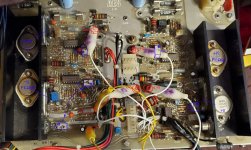mister-freeze
Member
In the meantime I could get my AES 103 running again. The +5V and -15V rail has been dead.
Phil's detailed report and his reverse-engineering here helped me a lot in repairing the power supply (Thanks PhilipA ).
The following shows you that your hardware is ok:
After power on there is no boot-up message at first. The Screen remains dark. But you should hear a continuous beep. This is the prompt to insert the system disk.
When inserting any floppy disk, a screen filled with ones should appear.
This is the error message for a missing boot disk.
Furthermore, there is now even a way to copy existing hardsectored AES floppies with a special Fluxbased Tool.
PhilipA Were you able to finish your hardware repair in the meantime ?
What I can say for sure is that the bootdisk from the 7100 does not work on the 103. The 7100 is Z80 based.
The text disk from the 7100, on the other hand, can be used.
Phil's detailed report and his reverse-engineering here helped me a lot in repairing the power supply (Thanks PhilipA ).
The following shows you that your hardware is ok:
After power on there is no boot-up message at first. The Screen remains dark. But you should hear a continuous beep. This is the prompt to insert the system disk.
When inserting any floppy disk, a screen filled with ones should appear.
This is the error message for a missing boot disk.
Furthermore, there is now even a way to copy existing hardsectored AES floppies with a special Fluxbased Tool.
PhilipA Were you able to finish your hardware repair in the meantime ?
I have boot disks for the AlphaPlus 12, and 14. I have a complete Alphaplus 12. The Alphaplus 14 disks also boot the 7100. I also have boot disks for the 7200 and 7300. As well as CPU's.
What I can say for sure is that the bootdisk from the 7100 does not work on the 103. The 7100 is Z80 based.
The text disk from the 7100, on the other hand, can be used.

